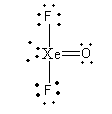
What is the Ratio of bond pair-lone pair electrons in ${\text{XeO}}{{\text{F}}_2}$ ?
Answer
557.7k+ views
Hint:To determine the ratio of bond pair-lone pair we have to determine the bond pair and lone pair first. For this we will write the Lewis geometry. Lewis structure shows the electron pairs around the atoms of a molecule. The Lewis structure includes both bonded as well as nonbonding electron density.
Complete step by step solution:The rules to write the Lewis structure are as follows:
Write the basic structure. Write the central atom around which writes all atoms of the molecule. The least electronegative atom is the central atom.
Count total valence electrons.
Two electrons are used in the formation of a bond.
Count the total electron used in bond formation.
Subtracts the electrons used in bond formation from the total valence electrons.
The Lewis structure of ${\text{XeO}}{{\text{F}}_2}$ is as follows:
Total valence electrons are as follows:
$ = \,\left( {8 \times 1} \right) + \left( {6 \times 1} \right) + \left( {7 \times 2} \right)$
$ = \,28$
The basic arrangement of atoms are as follows:

Xenon is forming four bonds, so the total electron used in the bonds are $8$.
The remaining valence electrons are,
$ = 28 - 8$
$ = \,20$
We will arrange the $20$ electrons to complete the octet of each atom.

So, the number of bond pairs of xenon is $4$and lone pairs are $2$. So, the ratio of bond pair-lone pair electrons is,
$ = 4/2$
$ = 2$
Therefore, the ratio of bond pair-lone pair electrons ${\text{XeO}}{{\text{F}}_2}$ is $2$.
Note: Each atom requires eight electrons to complete an octet except hydrogen. The hydrogen requires two electrons to complete the octet. The electron pair involved in bond formation is known as bond pair. The electron pair which remains non-bonded is known as lone pair. In a bond pair, each electron comes from each bonded atom. The electron density of lone pairs lies only on one atom. Electronegativity of xenon is less than oxygen and fluorine.
Complete step by step solution:The rules to write the Lewis structure are as follows:
Write the basic structure. Write the central atom around which writes all atoms of the molecule. The least electronegative atom is the central atom.
Count total valence electrons.
Two electrons are used in the formation of a bond.
Count the total electron used in bond formation.
Subtracts the electrons used in bond formation from the total valence electrons.
The Lewis structure of ${\text{XeO}}{{\text{F}}_2}$ is as follows:
Total valence electrons are as follows:
$ = \,\left( {8 \times 1} \right) + \left( {6 \times 1} \right) + \left( {7 \times 2} \right)$
$ = \,28$
The basic arrangement of atoms are as follows:

Xenon is forming four bonds, so the total electron used in the bonds are $8$.
The remaining valence electrons are,
$ = 28 - 8$
$ = \,20$
We will arrange the $20$ electrons to complete the octet of each atom.

So, the number of bond pairs of xenon is $4$and lone pairs are $2$. So, the ratio of bond pair-lone pair electrons is,
$ = 4/2$
$ = 2$
Therefore, the ratio of bond pair-lone pair electrons ${\text{XeO}}{{\text{F}}_2}$ is $2$.
Note: Each atom requires eight electrons to complete an octet except hydrogen. The hydrogen requires two electrons to complete the octet. The electron pair involved in bond formation is known as bond pair. The electron pair which remains non-bonded is known as lone pair. In a bond pair, each electron comes from each bonded atom. The electron density of lone pairs lies only on one atom. Electronegativity of xenon is less than oxygen and fluorine.
Recently Updated Pages
Why are manures considered better than fertilizers class 11 biology CBSE

Find the coordinates of the midpoint of the line segment class 11 maths CBSE

Distinguish between static friction limiting friction class 11 physics CBSE

The Chairman of the constituent Assembly was A Jawaharlal class 11 social science CBSE

The first National Commission on Labour NCL submitted class 11 social science CBSE

Number of all subshell of n + l 7 is A 4 B 5 C 6 D class 11 chemistry CBSE

Trending doubts
Differentiate between an exothermic and an endothermic class 11 chemistry CBSE

10 examples of friction in our daily life

One Metric ton is equal to kg A 10000 B 1000 C 100 class 11 physics CBSE

Difference Between Prokaryotic Cells and Eukaryotic Cells

State the laws of reflection of light

Explain zero factorial class 11 maths CBSE




